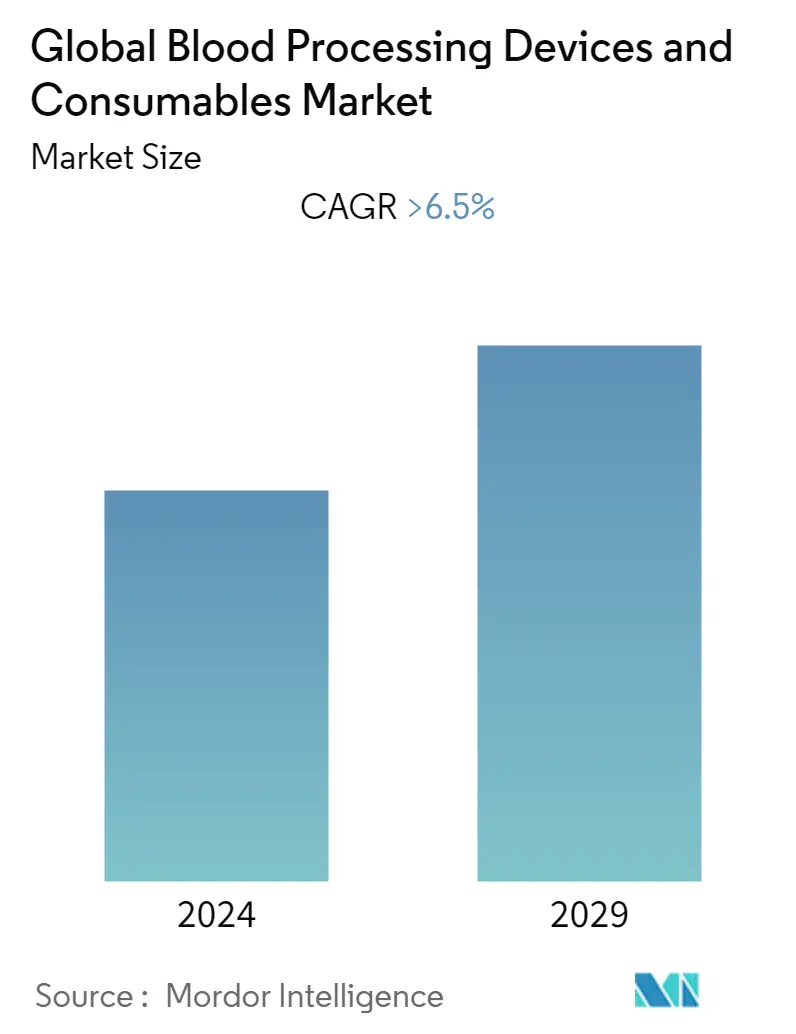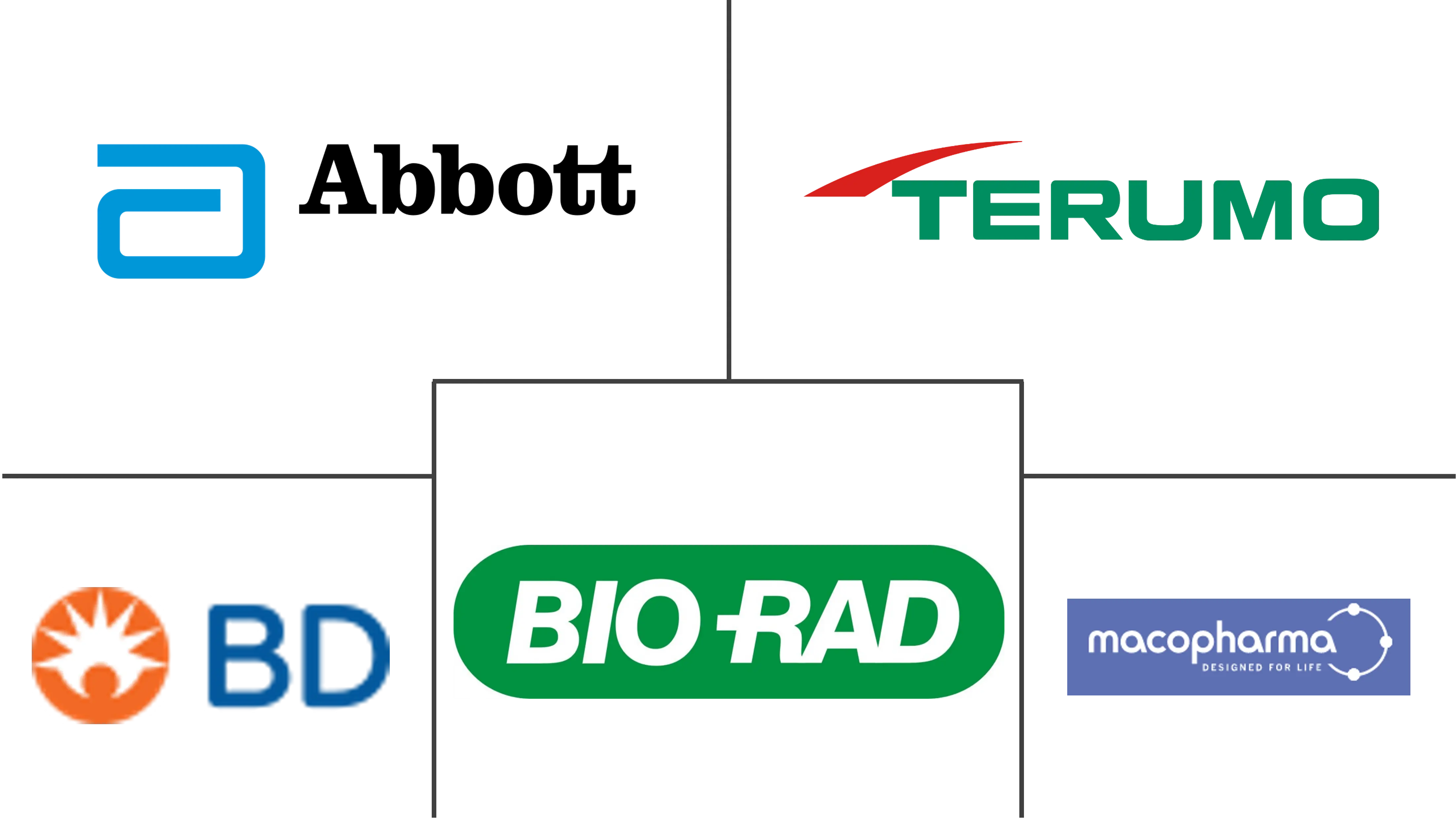Market Size of Global Blood Processing Devices and Consumables Industry

| Study Period | 2019 - 2029 |
| Base Year For Estimation | 2023 |
| CAGR | > 6.50 % |
| Fastest Growing Market | Asia-Pacific |
| Largest Market | North America |
| Market Concentration | Medium |
Major Players
*Disclaimer: Major Players sorted in no particular order |
Need a report that reflects how COVID-19 has impacted this market and its growth?
Blood Processing Devices & Consumables Market Analysis
The blood processing devices and consumables market is expected to register a CAGR of nearly 6.5% over the forecast period (2022-2027).
The COVID-19 pandemic has significantly impacted the blood processing devices and consumables market. The onset of the COVID-19 pandemic led to a reduction in demand for blood processing because surgical procedures were canceled across the globe. For instance, as per an October 2020 published study titled, "Elective Surgery Cancellations Due to the COVID-19 pandemic: Global Predictive Modeling to Inform Surgical Recovery Plans", it was estimated that 28,404,603 operations would be canceled or postponed during the peak 12 weeks of disruption due to COVID-19. As blood transfusion procedures and other surgeries require processed blood, this had a short-term negative impact on the market across the globe.
However, with the introduction of vaccines and the upliftment of restrictions on COVID-19, the number of surgical procedures is expected to increase, and the demand for blood processing is expected to grow in the coming period, which has led several organizations to adopt various measures that can benefit the market growth. For instance, in February 2021, the World Health Organization (WHO) emphasized the importance of being prepared and responding quickly and outlined key actions and measures that the blood services should take to mitigate the potential risk to the safety and sufficiency of the blood supplies during the pandemic. Additionally, as per an April 2022 published article titled, "The Impact of COVID-19 on Blood Transfusion Services: A Systematic Review and Meta-Analysis", blood centers should focus more on launching initiatives and policies that would increase their countries' blood supply as the virus has no direct threat to blood safety. This reflects the demand for blood processing products is expected to increase. Hence, the COVID-19 pandemic is expected to have a positive impact on the market in the coming period.
The major factors fueling the market growth are the growing burden of disorders requiring blood transfusion and surgical treatment, the growing number of initiatives in regenerative medicine and cell therapies as well as increasing geriatric population.
The growing burden of disorders requiring blood transfusion is driving the market growth as per a March 2021 update by the Centers for Disease Control and Prevention (CDC). People with inherited blood disorders such as thalassemia often require frequent blood transfusions to remain healthy. The source states that red blood cell transfusions are an important part of medical care for many people with thalassemia. For instance, as per a September 2020 published article titled, "Changing Patterns in the Epidemiology of β-thalassemia," the prevalence of β-thalassemia is increasing in other regions, including Northern Europe and North America, primarily due to migration. Thus, the increasing burden of such disorders is driving the demand for blood processing products.
Additionally, the growing number of disorders requiring surgeries such as orthopedic surgeries, cardiac surgeries, and spinal surgeries is contributing to the market growth. For instance, according to British Heart Foundation's February 2021 report, in 2020, in England, about 371,000 heart procedures and operations were performed, while in 2019, about 473,000 procedures were performed. Thus, the demand for blood processing products is increasing, thereby contributing to the market growth. Moreover, as per the research study published in September 2019, titled "Rates of Total Joint Replacement in the United States: Future Projections to 2020-2040 Using the National Inpatient Sample", if the current trend continues, then there may be a significant increase in the total hip arthroplasty (THA) and total knee arthroplasty (TKA) over the years, and by 2030, the projected count for primary THA maybe 572,000 and 3.5 million primary TKA. Thus, the growing burden of surgeries increases the need for blood processing devices and consumables.
Moreover, in October 2021, Terumo Blood and Cell Technologies, a United States-based medical technology company, inaugurated its newest manufacturing facility in La Lima, Cartago, Costa Rica. The USD 60 million, world-class manufacturing plant aligns with the company's mission of Contributing to Society through Healthcare and serving more patients. The company manufactures medical devices and products that are used to collect, separate, manufacture, and process blood and cells. Similarly, in March 2021, Grifols, a global leader in the development of plasma-derived therapies and leader in the development of innovative diagnostic solutions, reported its first-ever installation in North America of the DG Reader Net semi-automated analyzer, used to facilitate pre-transfusion blood type compatibility testing. This platform, the newest addition to the company's scalable solutions for blood banks, is now running at ThedaCare Medical Center-Wild Rose in Wisconsin.
However, stringent regulations and the high cost of blood processing devices are the major factors restraining the market growth.
